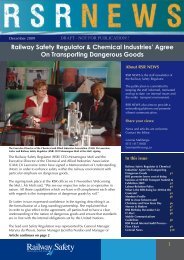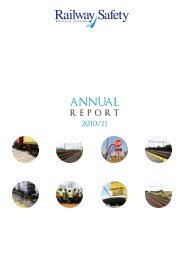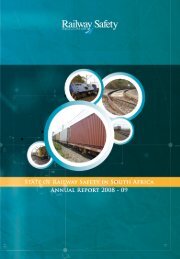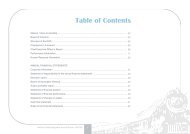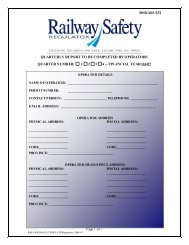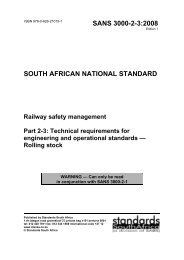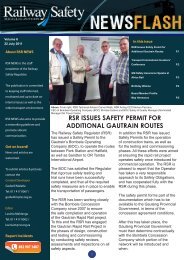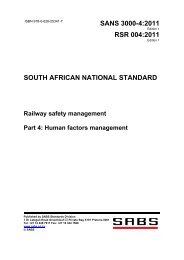SANS 3000-1:2009 - Railway Safety Regulator
SANS 3000-1:2009 - Railway Safety Regulator
SANS 3000-1:2009 - Railway Safety Regulator
- No tags were found...
Create successful ePaper yourself
Turn your PDF publications into a flip-book with our unique Google optimized e-Paper software.
<strong>SANS</strong> <strong>3000</strong>-1:<strong>2009</strong>Edition 212 Human factors management12.1 General12.1.1 The management of human factors as reflected in this clause is amplified in <strong>SANS</strong> <strong>3000</strong>-4,which is in course of preparation.12.1.2 Human factors is a holistic discipline that includes the perceptual, physical and mentalcapabilities and limitations of persons and the interaction of individuals with their respective workingand passenger environments, the influence of equipment and systems design on humanperformance, and the organizational characteristics that influence safety-related behaviour.12.1.3 The management of human factors applies a user-oriented philosophy that acknowledgeshuman variability as a parameter. The result incorporates features that take advantage of uniquehuman capabilities and also built-in safeguards to mitigate the impact of human error ormisbehaviour (or both). The benefit of a human factors management programme is measured bythe level of improved efficiency, safety, health and comfort for the user and optimized safety andproductivity for the organization.12.1.4 The management of human factors encompasses the following:a) human factors in design (human-system interface);b) psychological factors:1) psychosocial factors; and2) psychophysiological factors;c) physical environmental factors; andd) organizational factors.12.2 Human factors in design (human-system interface)12.2.1 The human-system interface is an interaction between persons and one or more physicalcomponents to bring about a desired output or to fulfil the function for which the human system isdesigned in order to optimize human performance and mitigate risks in railway operations.12.2.2 The work environment refers to the physical area in which tasks are performed. Theperformance of tasks is directly linked with the human-system interface. Human capabilities andlimitations are important factors to bear in mind when designing work interfaces, irrespective of theirsize or nature.12.2.3 The two aspects of the human anatomy that are of particular importance in the design ofsystem interfaces and equipment are anthropometrics (dealing with the size and proportions of thehuman body) and biomechanics (dealing with how the human body applies forces to itself andobjects with which it comes into contact, and how the human body is affected by external forces).These two aspects cover the limited ability of the human body to adapt to poor workplaces and theforces on and by the human body.32



